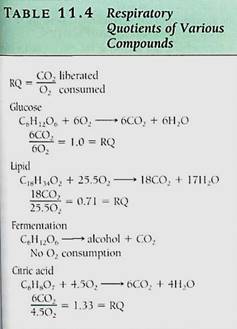


 النبات
النبات
 الحيوان
الحيوان
 الأحياء المجهرية
الأحياء المجهرية
 علم الأمراض
علم الأمراض
 التقانة الإحيائية
التقانة الإحيائية
 التقنية الحيوية المكروبية
التقنية الحيوية المكروبية
 التقنية الحياتية النانوية
التقنية الحياتية النانوية
 علم الأجنة
علم الأجنة
 الأحياء الجزيئي
الأحياء الجزيئي
 علم وظائف الأعضاء
علم وظائف الأعضاء
 الغدد
الغدد
 المضادات الحيوية
المضادات الحيوية|
Read More
Date: 17-10-2016
Date: 30-10-2016
Date: 1-11-2016
|
Respiratory Quotient
An action spectrum is a valuable tool for studying light-mediated phenomena such as photosynthesis. For respiration, a similar type of information is useful. A theoretical calculation can be made of the amount of oxygen consumed by each type of respiratory substrate. For example, the complete aerobic respiration of glucose should consume six molecules of oxygen and produce six molecules of carbon dioxide (Table 11.4).

Fhis ratio of carbon dioxide liberated to oxygen consumed is known as the respiratory quotient (RQ); for glucose RQ = 1.0. Acids can enter the citric acid cycle and be oxidized to carbon dioxide, producing NADH for the mitochondrial electron transport chain. Because acids contain relatively large amounts of oxygen in their molecular structure, less is needed to convert them to carbon dioxide and water, so their RQ is high, greater than 1.0. On the other hand, fatty acids contain virtually no oxygen, so when they are respired, enough oxygen must be consumed to oxidize not only every carbon but every hydrogen as well, so the RQ is very low, often about 0.7. Of course, anaerobic respiration consumes no oxygen, although its carbon dioxide production is very high.
Once these RQ values are calculated, it is relatively easy to measure the amounts of gases exchanged during respiration and thus gain information about the respiratory metabolism. For example, peanut seeds are rich in lipids and oils. As they germinate, the seedling's RQ is initially low, indicating that the lipids are being respired. If they are kept in the dark, the RQ remains low until the seedling exhausts its nutrient reserves and dies. But if they are allowed to germinate in the light, the RQ gradually increases toward 1.0 as photosynthesis begins to produce glucose needed for respiration (Fig.). Fhe increase is not immediate, because much of the first products of photosynthesis are used for constructive anabolic reactions in the leaf cells, so a rise in the RQ indicates that leaf photosynthesis is meeting anabolic needs and producing extra for respiration.

FIGURE :Sunflower seeds store oils in their cotyledons; when they germinate, the oils are respired, giving the seed a low RQ value. The cotyledons of this seed, although still enclosed by the seed coal, have turned green and are carrying out photosynthesis, so both oils and sugars are available for respiration. After a few days, all the oil will be consumed, then only photosynthetically produced sugars will be available, and the seedling will have a high RQ value, near 1.0.



|
|
|
|
"أسترازينيكا" تعترف.. لقاح كورونا يسبب آثارا جانبية مميتة
|
|
|
|
|
|
|
"الملح والماء" يمهدان الطريق لأجهزة كمبيوتر تحاكي الدماغ البشري
|
|
|
|
|
|
جمعيّة العميد وقسم الشؤون الفكريّة تدعوان الباحثين للمشاركة في الملتقى العلمي الوطني الأوّل
|
|
|
|
الأمين العام المساعد لجامعة الدول العربية السابق: جناح جمعية العميد في معرض تونس ثمين بإصداراته
|
|
|
|
المجمع العلمي يستأنف فعاليات محفل منابر النور في واسط
|
|
|
|
برعاية العتبة العباسيّة المقدّسة فرقة العبّاس (عليه السلام) تُقيم معرضًا يوثّق انتصاراتها في قرية البشير بمحافظة كركوك
|